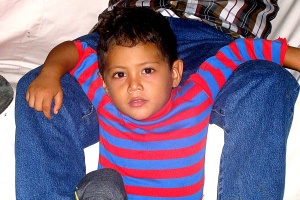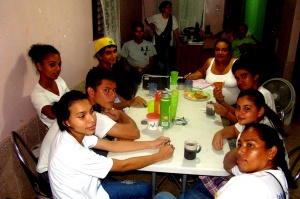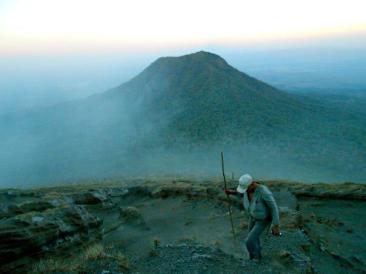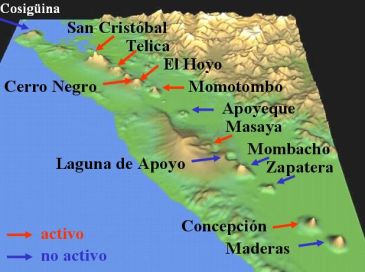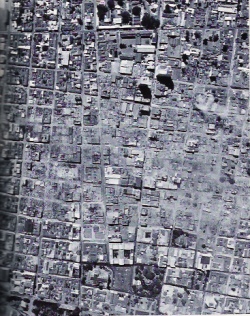Tired Baby Does Shavasana
August 21, 2013 § Leave a comment
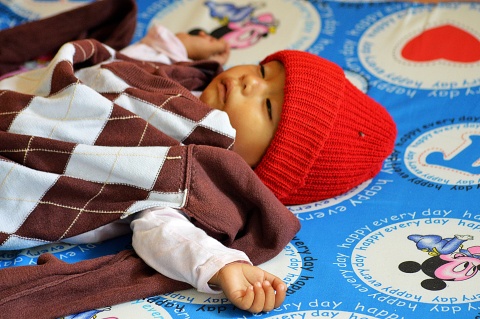
Somebody was snoozing during capacity building…
Who doesn’t like cute baby pictures? This is one from today’s capacity building with farmers from rural communities of El Salvador. The farmers are community leaders who are participating in a Trócaire livelihoods project, made possible thanks to the Big Lottery Fund. The goals of the project are to improve access to water in El Salvador’s most marginalized communities, enable farmers to diversify crops to heighten their families’ food security, promote leadership development, and bring about institutional change at the municipal and State levels through advocacy.
One of the women farmers who participated in today’s training arrived with her daughter. When the baby started getting restless, Super Mom set her down on a Disney mattress, which seemed to have appeared out of nowhere. Judging by the rapid onset of slumber, I’d say it did the trick.
Looking at the baby, I couldn’t help but think what kind of world she’ll be growing up in. How will she fare with the realities of climate change and water contamination that threaten El Salvador, which is one of the top five countries in the world to be most negatively impacted by climate change? Will she be a farmer, like her mom? Will she want to go to school? If so, will she have the means to do so? Will resources find their way to her in a starkly unequal society? Will she use them on shoes, bags, and phones, or will she invest in something that has more value? How will she define value?
The answers to these questions are impossible to know. For now, she sleeps, perfectly oblivious to the fact that she is the cutest baby on the planet.
Taking Down Machismo: The “Fight” Against Gender-based Violence
August 4, 2013 § Leave a comment
In 2005 I spent two weeks living with a Costa Rican family. My host mother, Sandra, was a vibrant woman who liked salsa dancing, bright clothes, and chatting over meals and torrential rainstorms.
Sandra’s husband, on the other hand, was a total contrast — expressionless, reserved, and practically mute.
“I married him because he’s not like the rest,” Sandra told me. “He’s never hit me, and he doesn’t sleep around.”
I found it odd that what Sandra’s husband wasn’t could justify their marriage.
What I didn’t realize at the time was that Sandra was protecting herself from a reality that women face around the globe. According to the World Health Organization’s latest report on violence against women, over one-third of all women (over 1.25 billion) have experienced physical and/or sexual violence. Moreover, thirty percent of all women who have been in a relationship have experienced physical and/or sexual violence by their intimate partner.
Sandra’s story remained with me for eight years, until I recently found myself back in Costa Rica evaluating the progress of Trócaire’s Prevention of Gender Based Violence (GBV) Program. Trócaire, an Irish development agency, funds eleven civil society organizations in Nicaragua and Costa Rica committed to preventing GBV and responding to cases of abuse through psycho-social, community, and legal support. The program currently works with 850 women.
One of those women is Teresa. I met Teresa in Upala, Costa Rica at the Center of Migrant Social Rights (CENDEROS). Sitting in the middle of a cluster of adolescents, Teresa played the role of unassuming yet supportive mother. Little did I know the inferno she had been through to get to that seat.
Teresa moved from Nicaragua to Costa Rica with her family when she was eight. She lived with her mother and stepfather, whose relationship eventually dissolved. When she was sixteen, Teresa was forced to marry her step-father, who had already been abusing her for three years. For fifteen more years she experienced a constant mix of physical, verbal, and psychological abuse.
“He was in the war in Nicaragua,” she said, referring to the U.S.-backed Contra War between 1981 and 1989. “He’s still in the war.”
Teresa’s step-father/husband threatened her repeatedly with death. At the same time, he forced her to produce life — six lives to be exact, even though Teresa did not want to bear him any children.
Eventually, Teresa found her escape. She applied for a non-profit housing initiative for low-income women and succeeded in securing a modest home. She packed up her children and moved to San José.
It didn’t take long for Teresa’s husband to force himself back into her life. After tracking Teresa down, he remained violent, his wartime trauma still untreated. On one occasion, he left the house slashing his machete and screaming death threats at the neighbors’ children. A self-made outcast within the barrio, he ultimately left Teresa on his own accord.
Teresa continued taking advantage of every opportunity that non-profit organizations were offering in the area. That was what brought her to CENDEROS, where she participated in psychological counseling and gender training.
For the first time in her life, Teresa vocalized what she had undergone over the previous fifteen years. The act cast her into a tranced, zombie-like state. To this day, she can’t recall any of the details of that session. She only remembers white.
Through CENDEROS, Teresa learned about the law and her rights. She acquired entrepreneurial skills and enrolled herself in primary school, since she hadn’t finished the fifth grade. Today, she is close to graduating from high school. She plans on studying psychology at the university level so she can become a counselor for abused women.
“Despite the violence we’ve experienced, women can move forward,” Teresa says. “We need organizations like CENDEROS. They show us that violence isn’t the way to live. Many women have been able to save their homes. Others haven’t.”
“Migrant women residing in Costa Rica are exposed to sexual harassment, labor exploitation and increased incidence of rape, sexual abuse, and femicide,” says Adilia Solis, Director of CENDEROS. “The conditions of poverty, poor health, rootlessness, and isolation of these populations, the feeling of helplessness that prevails among them, trigger the cycle of violence.”
One of the main reasons for CENDEROS’s success in preventing GBV is that it works directly with boys and men on reconceiving “masculinity” in hyper-machista societies. This involves deconstructing their upbringings, personal traumas, and how their surroundings have shaped their behavior. They come to learn that it is in everyone’s interests to allow women to do basic things like come and go from the home when they choose, share control of economic resources, engage in training and income generating activities, and make decisions.
“When a man says that he’s ready to change, it’s incredible,” Teresa says. “It’s the beginning of a new kind of relationship.”
While Trócaire’s program works with over 770 men in Nicaragua and Costa Rica, challenges persist. There are men involved who still exhibit violent behavior, and there aren’t enough resources to handle the overwhelming demand for individual psychological attention. But changing attitudes and practices prove that it is possible to unlearn machismo.
This prevention work, if replicated at a large enough level, could generate a new way in which men and women interact, inspiring healthier relationships while halting deformational cycles of violence.
The hope of these interventions is not only that women like Sandra and Teresa won’t have to fear “the other” any longer. It’s also so men and women can learn that “the other” is just a social construction — something that facilitates expressions of violence on the basis of nothingness.
This blog post was published previously on Huffington Post on July 31, 2013 and can be accessed here.
Died Three Times and Still Standing: Security Training in Nicaragua
July 8, 2013 § Leave a comment
My face was buried in the dirt, my hands protecting my head from physical threats, whether they be kicks or bullets. My colleagues were somewhere in the grass after a group of masked gangsters seized our vehicle and held us at gunpoint in the middle of an abandoned soccer field.
Such was the first simulation I found myself in during SSAFE training at the National Police Academy in Managua, Nicaragua. The training, organized by the United Nations, was aimed at preparing NGO workers for situations that could compromise our safety and, perhaps, our lives.
The risks that international development and aid workers face are real. In Nicaragua, chief security threats include robbery with intimidation and/or violence, assaults, riots, earthquakes, tsunamis, hurricanes, landslides, inundations, floods, fires, volcanic ash, lava streams, and pyroclastic flows, just to name a few.
But fear not! Despite the seemingly endless list of horrors, Nicaragua is a wonderful country to live in and is still the third best place to go in 2013. After Costa Rica, Nicaragua is the “safest” country in Central America. Limiting our focus to homicides, Nicaragua has a murder rate of 13.6 homicides/100,000 inhabitants. This is compared to a rate of 38.5 homicides/100,000 inhabitants in Guatemala, 69.2 in El Salvador, and 91.6 in Honduras, which wins the title of “most dangerous country in the world.” (The U.S. homicide rate is a mere 4.8 homicides/100,000 inhabitants).
When it comes to security, we can’t assume we’re safe based on homicide statistics alone. For instance, I lived in Honduras for two years and nothing ever happened to me (while one Peace Corps volunteer was shot and wounded on a bus, resulting in Peace Corps’ removal from the country). Prior to Honduras, I lived in Chile, the safest country in Latin America, with a homicide rate of 3.2 homicides/100,000 inhabitants. Yet Chile was the only place where I have ever been violently assaulted and robbed (by a gang of five men, no less).
Throughout Latin America and the Caribbean, natural disasters are an inevitability. The 7.0-magnitude earthquake in Haiti in 2010, which resulted in an estimated 220,000 deaths, and the 8.8-magnitude earthquake in Chile that same year (525 deaths) are testaments to that. In Nicaragua, a 6.2-magnitude earthquake in 1972 claimed 20,000 lives, injured 15,000, and destroyed 85 percent of all buildings in Managua.
On June 15, 2013, a 6.5-magnitude earthquake 50 kilometers off of Nicaragua’s Pacific coast shook Managua for about 18 seconds. I was in the middle of a class when the building started to tremble and was surprised by how long it took me to realize that the earth was shaking. Thankfully, my Nicaraguan classmates helped keep the peace, encouraging us to follow proper earthquake protocol while exiting the building in an orderly manner.
One of my peers, a Nicaraguan woman who had lived through the 1972 earthquake and several subsequent tremors, predicted the most recent quake’s magnitude to a tee.
“That felt like a 6.5,” she said. “I’d bet money on it!”
Had the epicenter of the earthquake been Managua, like it was in 1972, the effects would have been devastating. According to the Nicaraguan Institute of Territorial Studies (INETER), if the 1972 earthquake was to repeat itself today, approximately 9,000 people would lose their lives. While Managua is better situated now, with one or two-level buildings dominating throughout the city, many of its structures still do not comply with earthquake-resistant building codes. Unfortunately, Managua sits on an enormous seismic swarm, and seismologists predict that another quake should occur in the near future, based on historic trends.
It was only appropriate that our second simulation at SSAFE training would test our response to an earthquake. During what we were told would be a fact-finding investigation in a local community, the building we were in started shaking and people around us began shouting, “Terremoto!”
Our team leader told us to hit the ground and cover our heads and necks. The advice was good, but remaining in that position while we waited for the building to collapse on us was not. According to the Center for Disease Control and Prevention, during an earthquake people should seek cover under a sturdy table or desk. Apparently, standing in a doorway is to be avoided, since doorways are not necessarily stronger than other parts of buildings and do not always protect people from the main causes of injury — falling or flying objects. If an exit is close, it is wise to take it, getting out into the open and staying away from things like facades, wires, sinkholes, and fuel and gas lines.
The last simulation involved getting ambushed by a mob of angry protestors. The situation was not so dissimilar from one I encountered as a tourist in Peru in 2009. At the time, Peruvians had lit fires to block the road to Machu Picchu in response to the government’s attempts at water privatization. I remember having to communicate peacefully with the protestors, but as a tourist my negotiating power was slim to none. International workers can and should negotiate with local leaders in these types of situations, especially if they can prevent a collapse into violence.
Though I completed SSAFE training, I’m still no expert in security, as my performance went to show. By the end, I had technically died three times in the first two simulations alone and narrowly escaped kidnapping in the third. Despite my failures, I feel much more prepared for potential threats. My senses have been sharpened, as proven by the sudden movements I now make to protect myself every time I hear any sort of bang. My friends tease me, telling me I have to relax. But the truth is that we never know when these things might happen, and it’s better to be prepared for the worst should the unwanted ever unfold.
This blog entry was published on Huffington Post on July 8, 2013 and can be accessed here.


